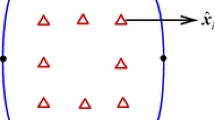Abstract
The low-order polynomial-distributed eigenstrain formulation of the boundary integral equation (BIE) and the corresponding definition of the Eshelby tensors are proposed for the elliptical inhomogeneities in two-dimensional elastic media. Taking the results of the traditional subdomain boundary element method (BEM) as the control, the effectiveness of the present algorithm is verified for the elastic media with a single elliptical inhomogeneity. With the present computational model and algorithm, significant improvements are achieved in terms of the efficiency as compared with the traditional BEM and the accuracy as compared with the constant eigenstrain formulation of the BIE.
Similar content being viewed by others
References
Eshelby, J. D. The determination of the elastic field of an ellipsoidal inclusion and related problems. Proceedings of the Royal Society of London, Series A, Mathematical and Physical Sciences, 241, 376–396 (1957)
Eshelby, J. D. The elastic field outside an ellipsoidal inclusion. Proceedings of the Royal Society of London, Series A, Mathematical and Physical Sciences, 252, 561–569 (1959)
Mura, T., Shodja, H. M., and Hirose, Y. Inclusion problems (part 3). Applied Mechanics Review, 49, S118–S127 (1996)
Federico, S., Grilloc, A., and Herzog, W. A transversely isotropic composite with a statistical distribution of spheroidal inclusions: a geometrical approach to overall properties. Journal of the Mechanics and Physics of Solids, 52, 2309–2327 (2004)
Cohen, I. Simple algebraic approximations for the effective elastic moduli of cubic arrays of spheres. Journal of the Mechanics and Physics of Solids, 52, 2167–2183 (2004)
Franciosi, P. and Lormand, G. Using the radon transform to solve inclusion problems in elasticity. International Journal of Solids and Structures, 41, 585–606 (2004)
Feng, X. Q., Mai, Y.W., and Qin, Q. H. A micromechanical model for interpenetrating multiphase composites. Computational Material Science, 28, 486–493 (2003)
Kompiš, V., Kompiš, M., and Kaukič, M. Method of continuous dipoles for modeling of materials reinforced by short micro-fibers. Engineering Analysis with Boundary Elements, 31, 416–424 (2007)
Doghri, I. and Tinel, L. Micromechanics of inelastic composites with misaligned inclusions: numerical treatment of orientation. Computer Methods in Applied Mechanics and Engineering, 195, 1387–1406 (2006)
Kakavas, P. A. and Kontoni, D. N. Numerical investigation of the stress field of particulate reinforced polymeric composites subjected to tension. International Journal for Numerical Methods in Engineering, 65, 1145–1164 (2006)
Kanaun, S. K. and Kochekseraii, S. B. A numerical method for the solution of thermo- and electrostatic problems for a medium with isolated inclusions. Journal of Computational Physics, 192, 471–493 (2003)
Lee, J., Choi, S., and Mal, A. Stress analysis of an unbounded elastic solid with orthotropic inclusions and voids using a new integral equation technique. International Journal of Solids and Structures, 38, 2789–2802 (2001)
Dong, C. Y., Cheung, Y. K., and Lo, S. H. A regularized domain integral formulation for inclusion problems of various shapes by equivalent inclusion method. Computer Methods in Applied Mechanics and Engineering, 191, 3411–3421 (2002)
Dong, C. Y. and Lee, K. Y. Boundary element analysis of infinite anisotropic elastic medium containing inclusions and cracks. Engineering Analysis with Boundary Elements, 29, 562–569 (2005)
Dong, C. Y. and Lee, K. Y. Effective elastic properties of doubly periodic array of inclusions of various shapes by the boundary element method. International Journal of Solids and Structures, 43, 7919–7938 (2006)
Liu, Y. J., Nishimura, N., Tanahashi, T., Chen, X. L., and Munakata, H. A fast boundary element method for the analysis of fiber-reinforced composites based on a rigid-inclusion model. ASME Journal of Applied Mechanics, 72, 115–128 (2005)
Ma, H. and Deng, H. L. Nondestructive determination of welding residual stresses by boundary element method. Advances in Engineering Software, 29, 89–95 (1998)
Nakasone, Y., Nishiyama, H., and Nojiri, T. Numerical equivalent inclusion method: a new computational method for analyzing stress fields in and around inclusions of various shapes. Materials Science and Engineering, A285, 229–238 (2000)
Qin, Q. H. Nonlinear analysis of Reissner plates on an elastic foundation by the BEM. International Journal of Solids and Structures, 30, 3101–3111 (1993)
Greengard, L. F. and Rokhlin, V. A fast algorithm for particle simulations. Journal of Computational Physics, 73, 325–348 (1987)
Ma, H., Yan, C., and Qin, Q. H. Eigenstrain formulation of boundary integral equations for modeling particle-reinforced composites. Engineering Analysis with Boundary Elements, 33, 410–419 (2009)
Ma, H., Xia, L. W., and Qin, Q. H. Computational model for short-fiber composites with eigenstrain formulation of boundary integral equations. Applied Mathematics and Mechanics (English Edition), 29, 757–767 (2008) DOI 10.1007/s10483-008-0607-4
Rahman, M. The isotropic ellipsoidal inclusion with a polynomial distribution of eigenstrain. ASME Journal of Applied Mechanics, 69, 593–601 (2002)
Nie, G. H., Guo, L., Chan, C. K., and Shin, F. G. Non-uniform eigenstrain induced stress field in an elliptic inhomogeneity embedded in orthotropic media with complex roots. International Journal of Solids and Structures, 44, 3575–3593 (2007)
Ma, H., Kamiya, N., and Xu, S. Q. Complete polynomial expansion of domain variables at boundary for two-dimensional elasto-plastic problems. Engineering Analysis with Boundary Elements, 21, 271–275 (1998)
Ma, H. and Qin, Q. H. Solving potential problems by a boundary-type meshless method-the boundary point method based on BIE. Engineering Analysis with Boundary Elements, 31, 749–761 (2007)
Ma, H., Zhou, J., and Qin, Q. H. Boundary point method for linear elasticity using constant and quadratic moving elements. Advances in Engineering Software, 41, 480–488 (2010)
Author information
Authors and Affiliations
Corresponding author
Additional information
Project supported by the National Natural Science Foundation of China (No. 10972131) and the Graduate Innovation Foundation of Shanghai University (No. SHUCX102351)
Rights and permissions
About this article
Cite this article
Ma, H., Guo, Z. & Qin, Qh. Two-dimensional polynomial eigenstrain formulation of boundary integral equation with numerical verification. Appl. Math. Mech.-Engl. Ed. 32, 551–562 (2011). https://doi.org/10.1007/s10483-011-1437-x
Received:
Revised:
Published:
Issue Date:
DOI: https://doi.org/10.1007/s10483-011-1437-x




